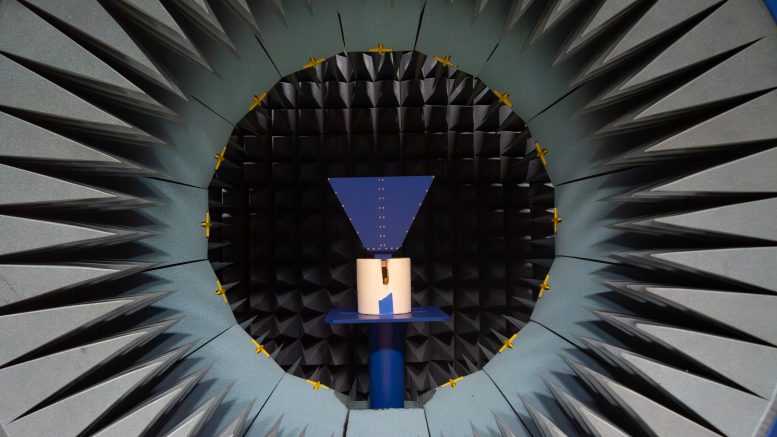In the fifth-floor antenna lab of the U of M Engineering and Information Technology Complex sits a shielded room with dark, pyramidal structures covering all the walls and ceilings.
The room, said Puyan Mojabi, professor in the department of electrical and computer engineering, is an anechoic chamber. It is designed to provide an environment free of unwanted electromagnetic waves, a type of radiation that moves through space and forms when an electric and magnetic field are linked. These waves encompass a wide spectrum of frequencies and wavelengths — from radio waves used in wireless communication to X-rays used in medical imaging.
The pyramidal structures on the walls and ceilings absorb electromagnetic waves, Mojabi said. The rest of the room is filled with measurement devices.
Mojabi held up a thin, almost poster-like structure, called a metasurface. The term “metasurface” is derived from the Greek word “meta,” meaning “beyond.”
“This surface can do things that are beyond regular surfaces,” Mojabi said.
Mojabi’s new research project is part of more than 150 projects being funded by Research Manitoba, three of which are part of grants totalling $346,500 over the course of two years. In total, the university has received $12.5 million in funding awards from different academic organizations.
Mojabi’s project, titled “Reconfigurable Electromagnetic Metasurfaces for Smart Radio Environments,” is attempting to improve wireless communication using metasurfaces.
The engineered surfaces consist of a thin dielectric layer with bits of metal shaped like an uppercase “I.” By altering the dimensions and arrangement of these I-shaped metallic inclusions, these surfaces can achieve a wide range of advanced functions beyond the capabilities of traditional materials.
In a standard wireless communication system, there are transmitters and receivers, with electromagnetic waves acting as the information carriers between them. However, the environment between these two points is typically uncontrollable, leading to potential data transmission issues that come from different obstacles and interferences.
“We have no control over the environment,” Mojabi said. “Sometimes the environment may block the transmission of data.”
A metallic wall, for example, could block the transmission of electromagnetic waves. In this case, a metasurface could reroute the electromagnetic waves around the obstacle, ensuring seamless connectivity. For this reason, Mojabi is interested in controlling the environment the signals travel through.
“You essentially try to engineer a surface and put it in the environment, in terms of a frame or a poster or things like that, so that it helps the transmission of data,” Mojabi explained.
This approach enables the environment to adapt to our communication needs, and can offer benefits such as higher data rates and even enhanced security in wireless communication.
Mojabi’s project explores how metasurfaces may be reconfigured.
“Reconfigurability means it can change its operation.” He explained.
While most designs are fixed in functionality, metasurfaces offer transformative capabilities. Mojabi’s goal is to develop metasurfaces capable of dynamically adapting to different tasks, akin to the versatile operation of electric transformers — a device that transmits electric energy from one circuit to another.
“In electric transformers, we have a systematic method that changes one voltage to another voltage,” Mojabi said. “I was always looking for something that can do the same thing for electromagnetic waves.”
Mojabi sees metasurfaces as similar to transformers designed for electromagnetic waves. By changing the configuration of the metallic inclusions on metasurfaces, these surfaces can perform multiple operations, catering to the specific needs of each moment.
“It’s a systematic procedure that, you give it an electromagnetic wave and it gives you what you desire,” he said.
While enhancing wireless communication remains a primary focus for Mojabi, metasurfaces have other potential applications such as performing imaging. By incorporating reconfigurable metasurfaces into imaging systems, it becomes possible to adapt the energy focus in real time.
“Imagine you go to an electromagnetic-based imaging system and you want to image, for example, [the] human body or any other thing,” Mojabi said.
“You can make the imaging system reconfigurable to what’s really needed, because you can always get a preliminary image, and then you reconfigure the environment to focus the energy more in the direction that you need.”
This application could be invaluable in medical imaging, where precise targeting of suspicious regions can greatly enhance diagnostic accuracy.
Ultimately, Mojabi believes that his project, through the use of metasurfaces, could mark a pivotal shift in wireless communication and electromagnetic applications by enabling the environment itself to adapt and optimize communication.
“The environment in wireless communication is typically uncontrollable, but now, if you place these strategically in the environment, you can make the environment controllable,” he said.
For this reason, it is referred to as a smart radio environment.
“Now the environment can adapt itself to the need of the people in the environment.”





